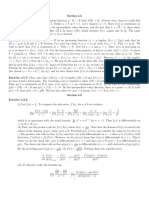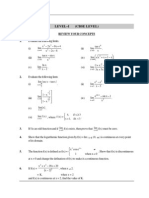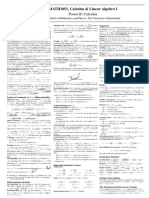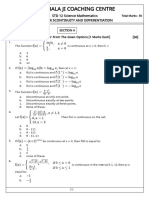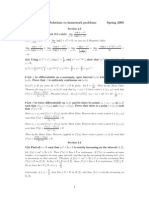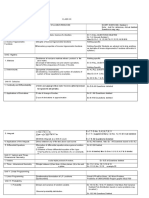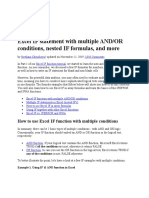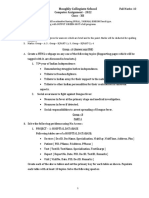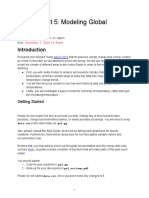THE UNIVERSITY OF HONG KONG
DEPARTMENT OF MATHEMATICS
MATH1013 University Mathematics II
Tutorial 5 Solutions
f (x) − f (0)
1. We need to compute lim . Firstly, we have
x→0 x−0
f (x) − f (0) sin x4 − 0 1 sin
x
1 1
lim− = lim− = lim− ( ⋅ x 4 ) = ⋅ 1 = .
x→0 x x→0 x x→0 4 4
4 4
Secondly, we have
√
f (x) − f (0) x+4−2−0 1 1
lim+ = lim+ = lim+ √ = .
x→0 x x→0 x x→0 x+4+2 4
f (x) − f (0) 1
Therefore, we have f ′ (0) = lim = , and f is differentiable at 0.
x→0 x−0 4
2. (a) It is clear that f is continuous at every point x ≠ 1 since polynomials and radicals are
continuous. For x = 1, we need lim− f (x) = lim+ f (x) = f (1). This holds if and only if
x→1 x→1
√
lim− (x2 + ax + b) = lim+ x + 8 = 1 + a + b.
x→1 x→1
This means 1 + a + b = 3. Thus, a and b can be any real numbers satisfying a + b = 2.
f (x) − f (1)
(b) Since f is differentiable at 1, the limit lim exists. Firstly, we have
x→1 x−1
f (x) − f (1) (x2 + ax + b) − (1 + a + b) (x − 1)(x + 1 + a)
lim− = lim− = lim−
x→1 x−1 x→1 x−1 x→1 x−1
= lim− (x + 1 + a) = 2 + a.
x→1
Secondly, we have
√ √
f (x) − f (1) x + 8 − (1 + a + b) x+8−3 1 1
lim = lim+ = lim+ = lim+ √ = .
x→1+ x−1 x→1 x−1 x→1 x−1 x→1 x+8+3 6
1 11 23
Therefore, the limit exists if and only if 2 + a = , i.e. a = − and b = 2 − a = .
6 6 6
1 2
3. When we derive the formula f ′ (x) = x− 3 using differentiation rules, we are assuming x ≠ 0.
3
Therefore, in general it does not indicate the existence or the value of f ′ (0).
Here provides a correct proof. By definition, we compute
1
f (x) − f (0) x3 − 0
= lim x− 3 .
2
lim = lim
x→0 x x→0 x x→0
This limit does not exist (in fact it is ∞). So f is not differentiable at 0.
1
�4. (a) Obviously, f is differentiable at every nonzero point. It remains to check whether f ′ (0)
exists. By definition, we have to compute
f (x) − f (0) xk sin x1 − 0 1
lim = lim = lim xk−1 sin .
x→0 x x→0 x x→0 x
1 1
When k = 1, the limit is lim sin . Since sin oscillates between −1 and 1 indefinitely
x→0 x x
when x tends to 0, the limit does not exist.
When k ⩾ 2, we use the inequality
k−1 1 k−1
− ∣x∣ ⩽ xk−1 sin ⩽ ∣x∣ .
x
k−1 k−1
Since k − 1 ⩾ 1, both − ∣x∣ and ∣x∣ have limit 0 when x tends to 0. By the
sandwich theorem, we have
1
f ′ (0) = lim xk−1 sin = 0.
x→0 x
Therefore, f is differentiable when k ⩾ 2.
(b) It suffices to consider k ⩾ 2 since otherwise f ′ does not exist by part (a). For x ≠ 0, we
have
d 1 1 1
f ′ (x) = (xk sin ) = kxk−1 sin − xk−2 cos
dx x x x
by the product rule and the chain rule. Recall that f ′ (0) = 0 by part (a). Therefore, we
compute
f ′ (x) − f ′ (0) 1 1
f ′′ (0) = lim = lim (kxk−2 sin − xk−3 cos ).
x→0 x x→0 x x
1 1 1
When k = 2, the limit is lim (2 sin − cos ), which does not exist as the function
x→0 x x x
1
is unbounded for some x close to 0 (for example, when x = where n is a positive
2nπ
1 1 1
integer, we have 2 sin − cos = −2nπ).
x x x
1 1
When k = 3, the limit is lim (3x sin − cos ). The first term tends to 0 by the
x→0 x x
sandwich theorem as above, while the second term has no limit. Therefore, the limit
does not exist.
1 1
When k ⩾ 4, both xk−2 and xk−3 tend to 0. Since k sin and cos are bounded, we
x x
1 1
can show that both kxk−2 sin and xk−3 cos tend to 0 by the sandwich theorem as
x x
above. Therefore, the limit is 0 and f ′′ (0) = 0.
To conclude, f ′′ (0) exists when k ⩾ 4.
5. (a) Note that g ′ (x) = f ′ (x) cos f (x) is continuous. Also, we have g ′ (0) = f ′ (0) cos f (0) = 3.
Thus, we can find a small open interval I containing 0 such that g ′ (x) ≠ 0 for all x ∈ I
(because g ′ (x) is close to 3 when x is close to 0). By the inverse function theorem, g has
an inverse on I.
2
� 1 1
(b) Note that g(0) = 1 + sin f (0) = 1. By the inverse function theorem, (g −1 )′ (1) = = .
g ′ (0) 3
6. We use implicit differentiation. Differentiating both sides with respect to x, we obtain
e2x (2yy ′ + 2y 2 ) = 2y ′ + 3x2 − 3.
21
Putting x = 0 and y = 3, this gives 6y ′ + 18 = 2y ′ − 3, i.e. y ′ = − . This shows the slope of the
4
21 21
tangent line at (0, 3) is − . As the line passes through (0, 3), its equation is y = − x + 3.
4 4
Additional problems:
7. (a) By definition,
f (x) − f (2) x2 − 4
f ′ (2) = lim = lim = lim (x + 2) = 4.
x→2 x−2 x→2 x − 2 x→2
(b) By definition,
3
f (x) − f (1) −3
′ x −3
f (1) = lim = lim = lim = −3.
x→1 x−1 x→1 x − 1 x→1 x
(c) Using the relation sin x = − sin (x − π), we have
f (x) − f (π) x sin x − 0 sin (x − π)
f ′ (π) = lim = lim = lim (−x ⋅ ) = (−π)(1) = −π.
x→π x−π x→π x−π x→π x−π
sin y
Remark. Since we want to use the fact lim = 1, we manually change sin x to
y→0 y
− sin (x − π) so that the input x − π of the sine function does approach 0.
8. Note that 3
⎧
⎪ (−x − 3) 2
⎪
⎪
⎪ if x < −3,
⎪
⎪
⎪ 4−x
⎪
⎪
⎪
⎪ (x + 3) 32
⎪
f (x) = ⎨ if −3 ⩽ x < 4,
⎪
⎪
⎪ 4−x
⎪
⎪
⎪ 3
⎪
⎪
⎪ (x + 3) 2
⎪
⎪
⎪ if x > 4.
⎩ x−4
For x < −3, we have
33 1 3 1
d (−x − 3) 2 − 2 (4 − x)(−x − 3) 2 − (−x − 3) 2 (−1) (x − 18)(−x − 3) 2
f ′ (x) = = = .
dx 4 − x (4 − x)2 2(4 − x)2
For −3 < x < 4, we have
3 3 1 3 1
d (x + 3) 2 (4 − x)(x + 3) 2 − (x + 3) 2 (−1) (18 − x)(x + 3) 2
f ′ (x) = = 2
= .
dx 4 − x (4 − x)2 2(4 − x)2
3
� For x > 4, we have
3 1
′ d (x + 3) 2 (18 − x)(x + 3) 2
f (x) = =− .
dx x − 4 2(4 − x)2
For x = −3, we first note that
RRR 3 R 1
f (x) − f (−3) R 1 ⎛ ∣x + 3∣ 2 ⎞RRR ∣x + 3∣ 2
lim ∣ ∣ = lim RRRR ⋅ − 0 RRRR = lim = 0.
x→−3 x+3 x→−3 RR x + 3 ⎝ ∣x − 4∣
RR ⎠RRR x→−3 ∣x − 4∣
R
f (x) − f (−3)
By an example in class (classwork 3.1), we have f ′ (−3) = lim = 0. (Alterna-
x+3x→−3
tively, we can study the left-hand limit and the right-hand limit separately.)
Remark. Note that f is not defined at x = 4, so we do not need to consider the case x = 4.
9. If f is differentiable at 2, it must be continuous at 2 by proposition 4.2. Therefore, we must
have
c = lim+ f (x) = lim+ (x2 − 3x + 2) = 0.
x→2 x→2
(One may also check that the left-hand limit is 0 to confirm that f is continuous at 0. But
this is not necessary if we only wish to find out all possible candidates of c.) It remains to
check whether f is differentiable at 2 when c = 0. Firstly, we have
f (x) − f (2) tan (x − 2) − 0 sin (x − 2) 1
lim = lim− = lim− ( ⋅ ) = (1)(1) = 1.
x→2− x−2 x→2 x−2 x→2 x−2 cos (x − 2)
Secondly, we have
f (x) − f (2) (x2 − 3x + 2) − 0
lim+ = lim+ = lim+ (x − 1) = 1.
x→2 x−2 x→2 x−2 x→2
f (x) − f (2)
This shows lim = 1. Therefore, f is differentiable at 2 when c = 0.
x→2 x−2
Remark. The only elementary way to compute some limits involving trigonometric functions
sin y
is to use the fact lim = 1. That’s why we change tan to sin and cos in order to take out
y→0 y
such a factor from the limit. Of course a simpler method is to use L’Hôpital’s rule introduced
in subsection 4.3.
In the solution, we first use proposition 4.2 to determine the only possible choice of c. Although
this is not necessary (say, we can directly use the first principle to check whether f ′ (2) exists
for each c ∈ R), it is more convenient to solve this question in this way.
10. (a) It is given that f (−x) = −f (x) for all x. Differentiating both sides with respect to x, we
obtain −f ′ (−x) = −f ′ (x), i.e. f ′ (−x) = f ′ (x). This means f ′ is an even function.
(b) It is given that f (−x) = f (x) for all x. Differentiating both sides with respect to x, we
obtain −f ′ (−x) = f ′ (x). This means f ′ is an odd function.
4
�11. By the inverse function theorem, we have
d(ln x) 1 1 1
∣ = d(ex )
= a
= .
dx x=ea ∣ e x
dx x=a
12. We use implicit differentiation. Differentiating both sides with respect to x, we obtain
(2x + 2y + 2xy ′ ) cos (x2 + 2xy) = 1 + 2yy ′ .
1
Putting x = 0 and y = 1, this gives 2 = 1 + 2y ′ , i.e. y ′ = . This shows the slope of the tangent
2
1 1
line at (0, 1) is . As the line passes through (0, 1), its equation is y = x + 1.
2 2
13. Differentiating both sides with respect to x, we obtain
4x3 + 3y 2 y ′ + 3 = 4yy ′ . (1)
Putting x = 2 and y = −1, this gives 32 + 3y ′ + 3 = −4y ′ , i.e. y ′ = −5 (strictly speaking, it is
y ′ (2) = −5). Next, differentiating both sides of (1) with respect to x, we obtain
12x2 + 6y(y ′ )2 + 3y 2 y ′′ = 4(y ′ )2 + 4yy ′′ .
202
Putting x = 2 and y = −1, this gives 48 − 6(−5)2 + 3y ′′ = 4(−5)2 − 4y ′′ , i.e. y ′′ = . This means
7
202
f ′′ (2) = .
7











